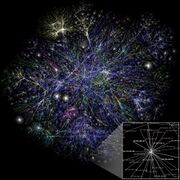Activity-driven model
| Network science | ||||
|---|---|---|---|---|
| Network types | ||||
| Graphs | ||||
|
||||
| Models | ||||
|
||||
| ||||
In network science, the activity-driven model is a temporal network model in which each node has a randomly-assigned "activity potential",[1] which governs how it links to other nodes over time.
Each node [math]\displaystyle{ j }[/math] (out of [math]\displaystyle{ N }[/math] total) has its activity potential [math]\displaystyle{ x_i }[/math] drawn from a given distribution [math]\displaystyle{ F(x) }[/math]. A sequence of timesteps unfolds, and in each timestep each node [math]\displaystyle{ j }[/math] forms ties to [math]\displaystyle{ m }[/math] random other nodes at rate [math]\displaystyle{ a_i=\eta x_i }[/math] (more precisely, it does so with probability [math]\displaystyle{ a_i \, \Delta t }[/math] per timestep). All links are then deleted after each timestep.
Properties of time-aggregated network snapshots are able to be studied in terms of [math]\displaystyle{ F(x) }[/math]. For example, since each node [math]\displaystyle{ j }[/math] after [math]\displaystyle{ T }[/math] timesteps will have on average [math]\displaystyle{ m\eta x_i T }[/math] outgoing links, the degree distribution after [math]\displaystyle{ T }[/math] timesteps in the time-aggregated network will be related to the activity-potential distribution by
- [math]\displaystyle{ P_T(k) \propto F\left(\frac{k}{m\eta T}\right). }[/math]
Spreading behavior according to the SIS epidemic model was investigated on activity-driven networks, and the following condition was derived for large-scale outbreaks to be possible:
- [math]\displaystyle{ \frac{\beta}{\lambda} \gt \frac{2\langle a\rangle}{\langle a\rangle + \sqrt{\langle a^2\rangle}}, }[/math]
where [math]\displaystyle{ \beta }[/math] is the per-contact transmission probability, [math]\displaystyle{ \lambda }[/math] is the per-timestep recovery probability, and ([math]\displaystyle{ \langle a\rangle }[/math], [math]\displaystyle{ \langle a^2\rangle }[/math]) are the first and second moments of the random activity-rate [math]\displaystyle{ a_j }[/math].
Extensions
A variety of extensions to the activity-driven model have been studied. One example is activity-driven networks with attractiveness,[2] in which the links that a given node forms do not attach to other nodes at random, but rather with a probability proportional to a variable encoding nodewise attractiveness. Another example is activity-driven networks with memory,[3] in which activity-levels change according to a self-excitation mechanism.
References
- ↑ Perra, Nicola; B. Gonçalves; R. Pastor-Satorras; A. Vespignani (2012-06-25). "Activity driven modeling of time varying networks". https://www.nature.com/articles/srep00469.
- ↑ Pozzana, Iacopo; K. Sun; N. Perra (2017-10-26). "Epidemic spreading on activity-driven networks with attractiveness". Physical Review E 96 (4). doi:10.1103/PhysRevE.96.042310. https://journals.aps.org/pre/abstract/10.1103/PhysRevE.96.042310.
- ↑ Zino, Lorenzo; A. Rizzo; M. Porfiri (2018-12-11). "Modeling Memory Effects in Activity-Driven Networks". SIAM Journal on Applied Dynamical Systems 17 (4): 2830–2854. doi:10.1137/18M1171485. https://epubs.siam.org/doi/abs/10.1137/18M1171485.
 |


